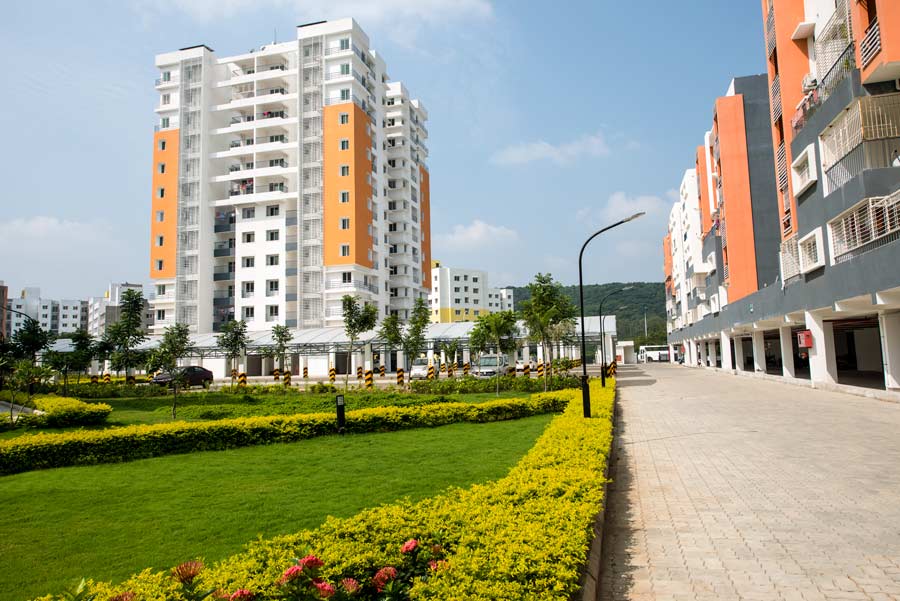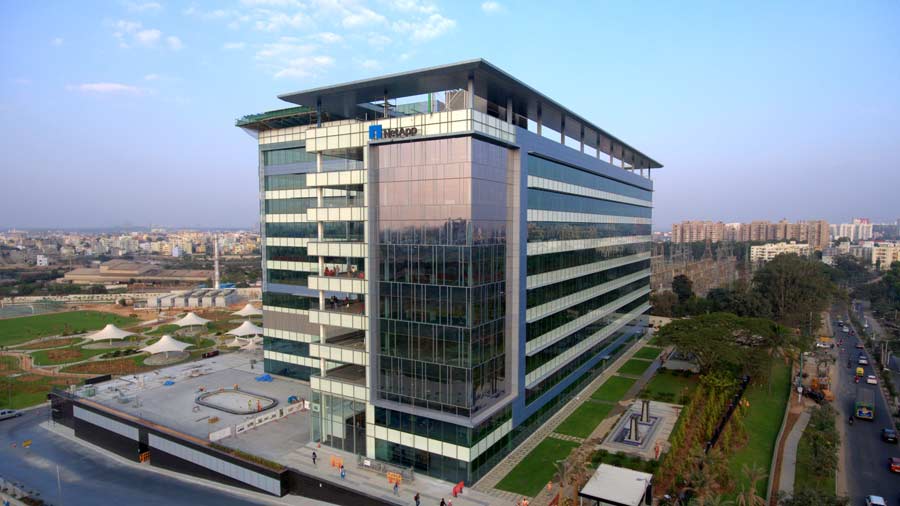The Green Alternative
Sep 1, 2020

Vasudevan Suresh (VS), chairman, IGBC, shares insights with your author (YP) on the council’s digitally launched rating system and aspects related to VT.

YP: The cost differential between normal and “green” buildings is only 1-2%. Do you see this driving the category’s growth?
[Alternative materials] often provide clear advantages over the more commonly used options and range from innovative new technology to materials and techniques that have been in use for thousands of years.
VS: Over the years, the cost differential between conventional and green buildings has come down drastically. This is primarily due to two reasons:
- Wide availability of high-performance products, materials and technologies: through its numerous platforms and events, the Indian Green Building Council (IGBC) has, since 2001, introduced many innovative and sustainable building materials, products and technologies. These include high-efficiency chillers, high-performance glass, fly-ash blocks, solar photovoltaic panels, waterless urinals, ecologically friendly paint and many others. In this direction, the Confederation of Indian Industry (CII), the parent body of IGBC, has launched the GreenPro rating for certification of green building products. Thus far, more than 1,000 products have been certified. GreenPro is recognized by the international nonprofit, Global Ecolabelling Network (GEN), which is a worldwide association of eco-labeling organizations.
- Highly scientific tools like energy simulation and lighting analysis were introduced to Indian consultants by the IGBC. Until then, these tools were unheard of in the Indian building sector. To date, about 50 consultancies have been incubated, developed and trained on green building concepts by the IGBC. Today, these firms employ multiple IGBC-accredited professionals. These firms provide clients with vital design and construction input, which leads to cost savings.
Today, there should be no major barriers to developers adopting green building practices and achieving IGBC certification. All developers want to offer better value-added products with minimal cost overruns to potential buyers, tenants and investors.

YP: What is the significance of the digitally launched IGBC Green Service Buildings Rating System? How do you envisage it making a difference?
Today, there should be no major barriers to developers adopting green building practices and achieving IGBC certification.
VS: The system was digitally launched on May 23. This rating allows small buildings to holistically adopt green principles. The system is designed for both new and existing buildings, such as petroleum, police, bus and fire stations that are less than or equal to 2,500 m2 of built-up area. Offices, banks, retail and mixed-use office buildings that are less than or equal to 1,500 m2 can also adopt this rating. Any other small building typologies, fulfilling the above norms and not addressed under other IGBC Ratings, can also adopt it. We have received tremendous response and encouragement from stakeholders, and we expect more project registrations under this rating in coming days. In fact, the certification of the first project under this rating is already underway.
YP: What are the advantages of some of the unique, green concepts addressed in the IGBC rating system, such as passive architecture and use of alternative construction technologies/materials?
VS: Green buildings using passive design (including architectural, structural, envelope and passive mechanical) strategies are optimized for interaction with the local microclimate. The ultimate vision of passive design is to reduce requirements for active mechanical systems and associated fossil-fuel-based energy consumption and to maintain occupant comfort at all times. Examples of passive design strategies include use of suitable orientation, shading devices or overhangs; punched or recessed windows; atriums; thermal massing; optimum window-to-wall-area ratio; lightweight shelves and pipes; and wind towers.
Logically controlled and regenerative elevators result in a significant reduction in energy consumption, when compared to conventional systems.
With environmental concerns playing an increasing role in how we design and build our homes and commercial buildings, alternative materials are growing in popularity. These often provide clear advantages over the more commonly used options and range from innovative new technology to materials and techniques that have been in use for thousands of years. It is crucial to select sustainable building materials that have been salvaged, recycled or are locally manufactured. This lowers the building’s ecological footprint. Adaptive reuse of existing materials, such as bricks, also helps minimize the need for new materials. Many IGBC-rated green building projects use these.
YP: The rating system also acknowledges and awards points to projects that address health, hygiene and COVID-19 concerns. Could you elaborate?
VS: The India and state governments have embarked on several initiatives to address issues related to people’s lives and livelihoods during the pandemic. The nationwide lockdown is one of the significant measures aimed at stopping the spread of infection. There could be multiple challenges to operationalize existing green buildings and carry out construction activities at new building sites once lockdown is lifted partially or in toto.
IGBC is fully aware of the importance of addressing the COVID-19 aspects of all typologies of new and existing buildings. To enable stakeholders to implement appropriate measures, IGBC (with input and support from experts and key stakeholders across the country) developed the guideline “Combating COVID-19 in Green Buildings.” To encourage upcoming and existing buildings to implement the guidelines, credit points will be awarded under IGBC Green Building Ratings for each of the following measures:
- Hygiene in buildings
- Heating, ventilation and air-conditioning and related equipment
- Water and plumbing fixtures
- Measures at construction sites
- People transit
These measures are illustrative and recommendatory. Projects can explore adopting measures over and above these guidelines to curb the spread of infection. Furthermore, the applicability of the IGBC Health and Well Being Rating in our current times should be mentioned. This rating is designed primarily for new and existing buildings in all developments. The rating has a holistic “whole body/mind” approach. It emphasizes people-centric design and stresses the following:
- Awareness of the importance of fitness and wise nutritional choices
- Improved visual, thermal and olfactory comfort
- Improved hygiene and better sanitation
- Creation of a caring environment and safer surroundings
- Lower sickness rates, physical strain and associated health impacts on occupants
The Role of VT
YP: Vertical transportation (VT) plays a key role in most buildings. How is this aspect covered by the rating system?
About Vasudevan Suresh
Vasudevan Suresh is a civil engineer from Anna University’s College of Engineering in Chennai. Focused on sustainable development, he has 54 years’ experience in housing, infrastructure and rural and urban projects. He is a fellow of the Institution of Engineers (India), the Indian Plumbing Association and the Royal Institution of Chartered Surveyors. He is a senior fellow at IGBC, and an honorable fellow of the Indian Institute of Architects, the Institution of Public Health Engineers–India and the Institution of Fire Engineers (India). Suresh is vice chairman of the National Building Code of India, chairman of the Housing Sectional Committee and member of the Bureau of Indian Standards’ Smart Cities Committee. He is also a member of the International Property Measurement Standards — Standard Setting Committee.
About the IGBC
The Indian Green Building Council (IGBC) was formed by the Confederation of Indian Industry (CII) in 2001. It is headquartered at CII — Green Business Centre in Hyderabad, one of CII’s Nine Centers of Excellence. This building was the first in India and third in the world to achieve a Leadership in Energy and Environmental Design (LEED®) Platinum rating from the U.S. Green Building Council (USGBC). Since 2019, this building has also achieved a Platinum net-zero-energy rating.
VS: VT has a significant impact on energy consumption. IGBC ratings always encourage projects to adopt the latest technology that lends itself to energy efficiency. In the case of VT, it is considered that efficient systems, like logically controlled and regenerative elevators, result in a significant reduction in energy consumption, when compared to conventional systems. Regenerative elevators are approximately 30% more efficient than conventional elevators. Consider a typical example: With a 1600-kg load (assuming 300,000 trips per year at 2.5 m/s), a conventional elevator would consume approximately 24,000 kW of electricity annually, whereas a regenerative elevator’s consumption would be 4,100 kW.
Energy savings also depend on the following parameters:
- Design capacity
- Travel speed
- Loading profile
- Travel distance
The above parameters enable a VT system to exhibit better energy efficiency. The cost of regenerative elevators is about 30-50% more than conventional elevators. Return on initial investment in a regenerative elevator system occurs in approximately five to eight years. This provides major energy-saving opportunities, especially in high-rise buildings.
YP: Does the rating system make any specific recommendations or have standardized norms for elevators and escalators?
VS: All IGBC Green Building Rating Systems encourage efficient lifts to minimize a building’s energy load. An example is the IGBC Green Mass Rapid Transit System (MRTS) rating. The MRTS rating recommends user-friendly elevator systems for enhanced public utility. The following are a few significant points to be considered under the rating system for a MRTS VT system. All elevators should:
- Be equipped with wide-access doors, handrails and control buttons at a convenient height
- Be equipped with Braille buttons inside and out
- Implement variable voltage, variable frequency (VVVF) technology (applies to escalators, as well)
- Have submetering
- Have an energy measurement and verification plan
IGBC also encourages its stakeholders to opt for emerging technologies such as voice-controlled and sensor-based elevators to stay ahead of the curve.
YP: How has RERA impacted green buildings? Do you see preference for green buildings from developers and end users emerging in specific real estate segments?
VS: To a large extent, RERA has ensured buyers get timely delivery of their residences with all the amenities promised by the developer during project launch. Almost all IGBC-rated green buildings ensure that amenities such as efficient taps and flush fixtures, rainwater harvesting, onsite sewage treatment plants, electric vehicle charging stations, organic waste converters, efficient air-conditioners, recreational spaces and ample greenery are provided. Daylight and ventilation are given supreme importance in all regularly occupied spaces. These features and the corresponding benefits are showcased as key selling points in a project’s marketing material. Most buyers care about these green features. RERA has strengthened developers’ commitment to deliver all the promised features before handover.
India Gets Greener
Green-building projects are on the rise in India. As of May 31, 5,918 projects from the government and private sectors had adopted various IGBC ratings. This is equivalent to a green footprint of 7.17 billion ft2. This includes 1.37 million residences and 577,000 acres of large developments (green campuses, townships and cities). Below is a breakdown.
Compared to conventional facilities, IGBC-rated green buildings have resulted in tremendous reductions in CO2 emissions, construction waste going to landfills, and energy and water usage. More importantly, green buildings have led to enhanced health and well-being of occupants. With the support of all stakeholders, the green-building movement in India continues to grow and touch the lives of citizens from all sections of society.
The vision of IGBC is to enable a “sustainable built environment for all.” To date, IGBC has achieved the following milestones:
- Developed 26 green building ratings covering nearly all types of projects
- Green-rated and closely worked with government bodies, public-sector enterprises and public-private partnerships on nearly 200 projects
- Awarded incentives by the Ministry of Environment and Forests and 10 state governments
- Accredited 4,451 IGBC professionals
- Trained more than 40,000 professionals on green-building concepts
- Collaborated with approximately 2,500 developers, corporate and government entities across India to achieve IGBC Green residential, commercial and industrial buildings
- Collaborated with metro authorities across the nation to get roughly 500 metro stations to adopt the IGBC MRTS rating.
- Encouraged 13 greenfield and smart cities across the country to adopt the IGBC Green Cities Rating
- Worked with schools, hospitals, campuses and townships to adopt green design, construction and operation practices in line with IGBC ratings






Get more of Elevator World. Sign up for our free e-newsletter.






